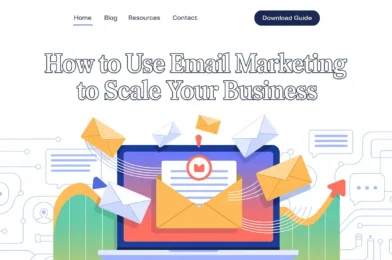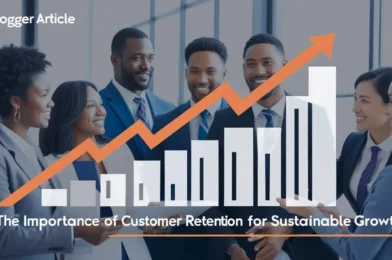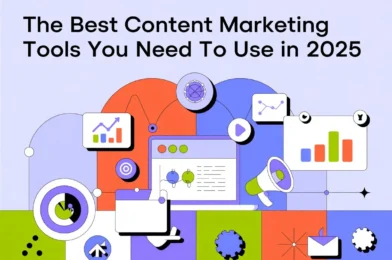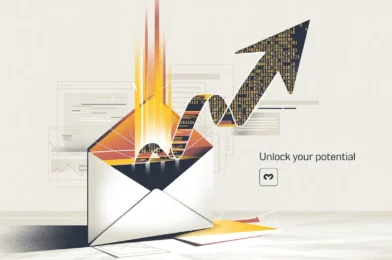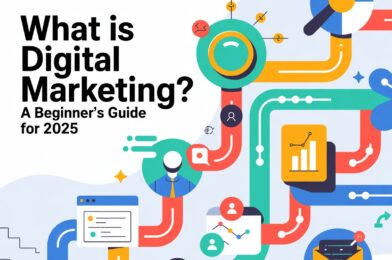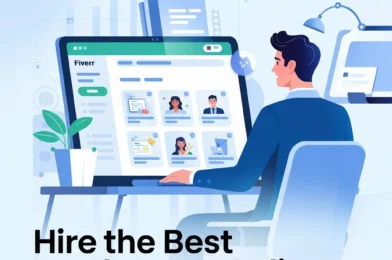In the dynamic landscape of digital marketing, businesses are constantly seeking sustainable strategies for growth. While shiny new platforms emerge frequently, one channel consistently delivers exceptional results and remains a cornerstone for scalable success: Email Marketing. Far from being outdated, email marketing, when executed strategically, offers an unparalleled ability to nurture leads, retain customers, and ultimately, drive significant revenue growth, making it indispensable for scaling your operations.
Understanding the fundamentals is key. If you’re new to the broader digital landscape, our Beginner’s Guide to Digital Marketing for 2025 provides a great starting point.
Why Email Marketing is Crucial for Scaling
Before diving into the ‘how,’ let’s solidify the ‘why.’ Why prioritize email marketing when aiming for significant business growth?
- Unmatched ROI: Email marketing consistently boasts one of the highest returns on investment among marketing channels. Studies frequently show ROIs of $36-$42 for every $1 spent (Litmus research often highlights these figures). This efficiency is vital when scaling, as resources need to be deployed effectively.
- Direct Line of Communication: Unlike social media platforms governed by algorithms, email provides a direct, personal channel to your audience. You control the message and the delivery (assuming good deliverability practices).
- Owned Audience: Your email list is a valuable asset you own. You’re not subject to the whims of platform policy changes or algorithm updates that can drastically reduce reach overnight. Building this owned audience is fundamental to sustainable scaling.
- Personalization at Scale: Modern email marketing platforms allow for deep personalization based on user data and behavior. This enables you to deliver highly relevant messages to large audiences, fostering stronger connections and driving conversions – a key component of scaling effectively.
- Nurturing and Retention Power: Scaling isn’t just about acquiring new customers; it’s also about retaining existing ones and increasing their lifetime value. Email is perfect for nurturing leads through the sales funnel and keeping existing customers engaged, loyal, and informed about new offerings.
Building a High-Quality Email List for Growth
You can’t scale with email if you don’t have a list, or if your list is low quality. Focus on attracting subscribers genuinely interested in your brand.
Lead Magnets That Convert
A lead magnet is a valuable resource offered for free in exchange for an email address. This is the foundation of ethical and effective list building.
- Ebooks & Guides: In-depth resources solving a specific problem for your target audience.
- Checklists & Templates: Actionable tools that simplify a task.
- Webinars & Workshops: Live or recorded sessions offering valuable insights or training.
- Exclusive Discounts & Early Access: Particularly effective for e-commerce businesses.
- Free Trials & Demos: Ideal for SaaS and service-based businesses.
Key takeaway: Your lead magnet must offer genuine value directly related to your core offerings and target audience’s needs.
Strategic Opt-in Form Placement
Make it easy for interested visitors to subscribe. Place clear, compelling opt-in forms in strategic locations:
- Website Header/Footer: Persistent visibility across your site.
- Blog Posts & Sidebars: Contextually relevant offers alongside valuable content.
- Dedicated Landing Pages: Focused pages designed specifically for lead magnet sign-ups, often used in ad campaigns.
- Exit-Intent Pop-ups: Offer a last-chance incentive before a visitor leaves. Use these judiciously to avoid annoyance.
- Checkout Process: For e-commerce, offer newsletter sign-up during purchase (ensure compliance with regulations like GDPR/CAN-SPAM).
Keep forms simple: typically, name and email are sufficient initially. Clearly state the value proposition – what will they receive by subscribing?
Leveraging Content Marketing and Social Media
Your content marketing efforts are prime real estate for list building. Promote your lead magnets within blog posts (as content upgrades), videos, and podcasts. Utilize social media bios, posts, and stories to drive traffic to your landing pages. Consider using social media lead ads specifically designed for email capture. Remember that effective content creation often requires the right tools; check out our guide on The Best Content Marketing Tools You Need to Use in 2025.
Segmenting Your Audience for Maximum Impact
As your list grows, sending the same message to everyone becomes ineffective. Scaling successfully with email relies heavily on segmentation – dividing your list into smaller groups based on shared characteristics or behaviors.
Why segment? Because relevant messages get higher engagement (opens, clicks) and drive better results. Sending targeted campaigns feels personal and valuable, not like spam.
Common Segmentation Criteria
- Demographics: Location, age, gender, job title (especially for B2B).
- Sign-up Source: Where did they subscribe from? (e.g., specific lead magnet, webinar registration).
- Purchase History: Past purchases, purchase frequency, average order value.
- Email Engagement: How often they open/click your emails (highly engaged vs. inactive).
- Website Behavior: Pages visited, content downloaded, products viewed (requires integration with your website analytics).
- Expressed Interests: Based on preference center choices or clicked links.
- Stage in Customer Lifecycle: New subscriber, active customer, lapsed customer, lead.
Implementing Segmentation Effectively
Most reputable Email Service Providers (ESPs) offer robust segmentation tools using tags, groups, or custom fields. Start simple – perhaps segmenting by lead magnet downloaded or differentiating leads from customers. As you scale, your segmentation can become more sophisticated, layering multiple criteria for highly targeted campaigns.
Crafting Emails That Convert and Nurture
A growing, segmented list is useless without emails that resonate and drive action. Focus on quality content and clear objectives for each campaign.
Compelling Subject Lines and Preheaders
Your subject line is the gatekeeper. It needs to grab attention in a crowded inbox. The preheader (the preview text shown after the subject line) provides valuable extra space to entice opens.
- Be Clear & Concise: What’s the email about?
- Create Urgency/Scarcity: “Limited time,” “Ends soon.”
- Spark Curiosity: Ask a question or hint at valuable information.
- Personalize: Use the recipient’s name or reference past behavior.
- A/B Test: Always test different subject lines to see what works best for your audience.
For more detailed strategies on getting your emails opened, delve into our article on Powerful Email Campaign Optimization: 7 Proven Strategies for Impressive Open Rates.
Personalized and Relevant Content
Go beyond just using the recipient’s first name (`[FNAME]`). Leverage your segmentation data to tailor the content:
- Dynamic Content Blocks: Show different images, text, or offers based on segment rules (e.g., show menswear to male subscribers, womenswear to female subscribers).
- Behavior-Triggered Content: Reference products they viewed or abandoned in their cart.
- Interest-Based Recommendations: Suggest blog posts or products related to links they’ve clicked previously.
The goal is to make each subscriber feel like the email was written specifically for them.
Strong Calls to Action (CTAs)
Every email should have a clear purpose and a corresponding CTA. What do you want the reader to do next?
- Use action-oriented language (e.g., “Shop Now,” “Learn More,” “Download Your Guide,” “Register Today”).
- Make CTAs visually prominent (use buttons, contrasting colors).
- Ensure the CTA links directly to the relevant landing page.
- Don’t overwhelm with too many competing CTAs in one email.
Mobile Optimization is Non-Negotiable
A significant portion of emails (often over 50%) are opened on mobile devices (HubSpot marketing statistics consistently confirm this trend). Your emails MUST be responsive:
- Use a single-column layout for easy scrolling.
- Keep subject lines relatively short to avoid truncation.
- Use large, legible fonts.
- Ensure buttons are large enough to be easily tapped.
- Test your emails on various mobile devices and email clients.
Automating Your Email Marketing for Scalability
Automation is where email marketing truly becomes a scaling powerhouse. It allows you to deliver timely, relevant messages to individuals based on their actions or characteristics, without manual intervention for every single email.
Welcome Series
When someone first subscribes, they are highly engaged. Capitalize on this with an automated welcome series (3-5 emails) to:
- Confirm subscription and deliver the lead magnet (if applicable).
- Introduce your brand story and values.
- Set expectations for future emails (frequency, content type).
- Highlight popular products, content, or resources.
- Offer a small incentive for a first purchase or engagement.
Lead Nurturing Sequences
Guide potential customers through the sales funnel. Trigger automated sequences based on actions like downloading a specific resource, visiting a pricing page, or attending a webinar. These emails should provide value, address potential objections, build trust, and gently guide leads towards conversion.
Abandoned Cart Recovery
For e-commerce businesses, this is crucial. Automatically send reminders (usually a series of 2-3 emails) to users who added items to their cart but didn’t complete the purchase. Include images of the items, social proof (reviews), and potentially a small discount to encourage completion. This single automation can recover significant lost revenue.
Post-Purchase Follow-ups
Don’t stop communicating after the sale. Automated post-purchase emails can:
- Confirm the order and provide shipping updates.
- Ask for product reviews or feedback.
- Offer tips on using the product effectively.
- Suggest complementary products (cross-selling).
- Invite customers to a loyalty program or community.
This builds customer loyalty and increases lifetime value – essential for scalable growth.
Measuring Success and Optimizing for Growth
You can’t scale what you don’t measure. Regularly track key email marketing metrics to understand what’s working and identify areas for improvement.
Key Metrics to Monitor
- Open Rate: Percentage of recipients who opened your email. Indicates subject line effectiveness and list health.
- Click-Through Rate (CTR): Percentage of recipients who clicked a link in your email. Measures content relevance and CTA effectiveness.
- Conversion Rate: Percentage of recipients who completed the desired action (e.g., made a purchase, filled out a form) after clicking. The ultimate measure of campaign success.
- Bounce Rate: Percentage of emails that couldn’t be delivered (hard bounce = permanent issue like invalid address; soft bounce = temporary issue like full inbox). High hard bounce rates hurt sender reputation.
- Unsubscribe Rate: Percentage of recipients who opted out. Monitor for spikes, which might indicate content irrelevance or sending frequency issues.
- List Growth Rate: How quickly your list is expanding. Crucial for scaling reach.
- Email Marketing ROI: Total revenue generated from email campaigns divided by the total cost (ESP fees, content creation, etc.).
A/B Testing for Continuous Improvement
Never assume you know what works best. Continuously test different elements of your emails:
- Subject lines
- Sender name
- Email copy and tone
- Call to Action (wording, color, placement)
- Images and design layout
- Send times and days
- Personalization elements
Test one element at a time to isolate the variable responsible for performance differences. Even small improvements, compounded over time, lead to significant scaling gains.
Cleaning Your Email List Regularly
Maintaining list hygiene is critical for deliverability and engagement. Periodically remove inactive subscribers (those who haven’t opened or clicked in a long time, e.g., 6 months) and hard bounces. Sending to unengaged contacts hurts your sender reputation and skews your metrics. Consider running re-engagement campaigns before removing inactive subscribers.
Advanced Scaling Strategies
Once you’ve mastered the fundamentals, consider these advanced tactics:
Integrating Email with Other Marketing Channels
Email doesn’t exist in a vacuum. Amplify its impact by integrating it with:
- Social Media Ads: Upload your email list (or segments) to platforms like Facebook to create custom audiences for retargeting or lookalike audiences for prospecting.
- SMS Marketing: For time-sensitive offers or important alerts, SMS can complement email (always get explicit opt-in for SMS).
- Content Marketing: Use email to promote your latest blog posts, videos, or podcasts, driving traffic back to your owned assets.
This creates a cohesive customer experience across multiple touchpoints, reinforcing your message and driving better results. Our Digital Marketing guide touches upon how these channels work together.
Leveraging Customer Lifecycle Marketing
Map out the typical journey your customers take, from awareness to advocacy. Develop targeted email sequences for each stage (e.g., onboarding for new customers, loyalty perks for long-term customers, win-back campaigns for lapsed customers). This strategic approach ensures you’re sending the right message at the right time, maximizing customer lifetime value.
Building Brand Advocacy
Use email to turn happy customers into brand advocates. Implement automated requests for reviews after a positive experience. Launch referral programs, incentivizing existing customers to spread the word. Encourage user-generated content by asking customers to share photos or stories related to your product/service.
Finding the Right Help When You Need It
Implementing sophisticated email marketing strategies for scaling can be complex and time-consuming. You might need expertise in copywriting, design, automation setup, or data analysis. While many tools exist, sometimes you need dedicated human talent.
If you find yourself needing specialized skills to design compelling email templates, write persuasive copy, set up complex automation workflows, or manage your campaigns, outsourcing can be a smart move. Many businesses find success by hiring freelance professionals. A great place to find talented individuals for specific tasks is Fiverr. You can connect with experienced email marketers, graphic designers, and copywriters who can help you execute your scaling strategy effectively.
Conclusion: Start Scaling with Email Today
Email marketing remains one of the most potent and cost-effective channels for scaling a business. By focusing on building a quality list, implementing smart segmentation and personalization, leveraging the power of automation, and consistently measuring and optimizing your efforts, you can transform your email program from a simple communication tool into a robust engine for growth.
The journey to scaling requires strategy, consistency, and a willingness to adapt. Don’t be overwhelmed by the possibilities. Start by implementing one or two key strategies – perhaps improving your lead magnet or setting up a welcome series. Build momentum from there.
Ready to harness the power of email marketing to scale your business? Begin by reviewing your current email strategy. Identify one key area for improvement based on this guide and commit to implementing it this month. Whether it’s enhancing your list-building efforts or setting up your first automated sequence, taking action is the first step towards significant growth.
